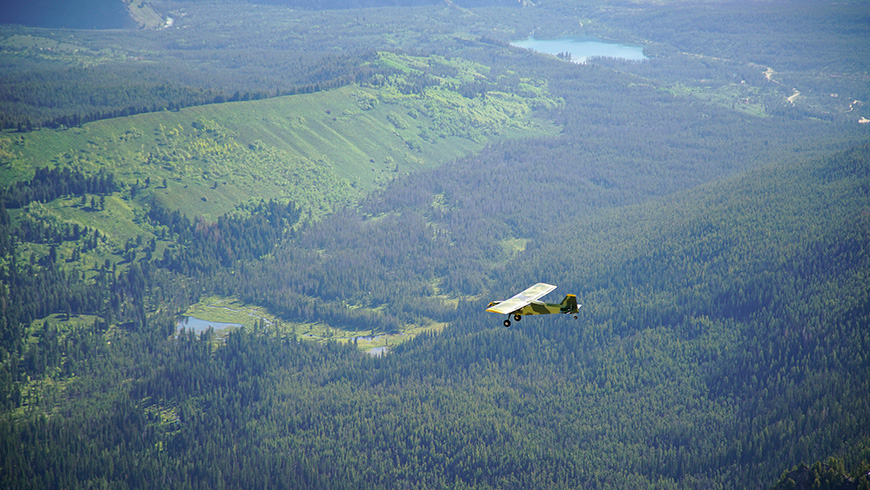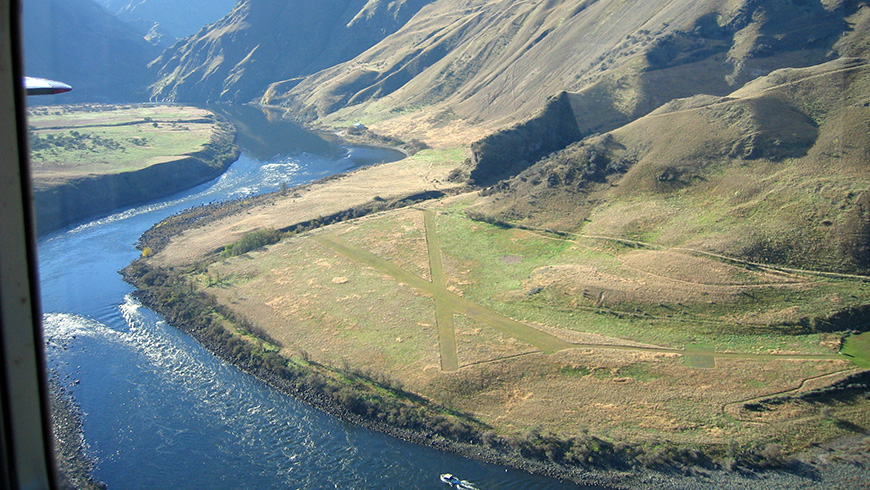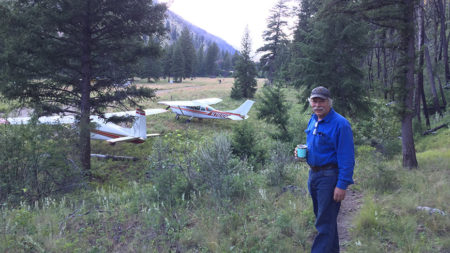It is a bright and clear Idaho morning.
The windsock floats in the periphery, filling with a gentle 9-knot breeze as we load up the Cessna 182 and Rans S-20 Raven for a flight north into the Idaho backcountry. Two planes stand waiting for takeoff after a preflight check and inspection—a Rans S-20 Raven piloted by retired commercial pilot (TWA and American Airlines) Preston Ziegler, and a Cessna 182 Skylane piloted by private pilot and backcountry guidebook author Galen Hanselman. The planes rise into the air, climbing through sunlight, which unfurls in sheets, crisp and clean, beyond the wingtips. A steady breeze provides lift as the planes climb smoothly past the Boulder Mountains, pink-tinged and glowing, slipping over Galena Summit and turning west towards the Sawtooths. It is a perfect day for flying.
The Rans S-20 Raven, an Federal Aviation Administration (FAA)-approved two-seater STOL (short takeoff and landing) kit aircraft, is particularly suited to the remote airstrips of central Idaho. The Cessna 182 Skylane, one of Cessna’s most popular models, is a four-seater, single-engine tricycle gear, light airplane introduced in 1956. It is the same model that pilot and backcountry flying expert Galen Hanselman has flown for the past three decades. Hanselman’s first airplane flight was over 42 years ago with good friend and beloved local pilot and Sun Valley Gun Club manager Captain Ben Hurtig, who offered Hanselman his first flight in 1976. From that moment on Hanselman was hooked, flying first for work as a way to cut down travel time for his home security business throughout southern Idaho; and later, for pleasure, after selling his company in the 1980s.
In fact, Hanselman loved flying so much that he decided to write a book about it.
“I had heard all the amazing stories about the magical places in the Idaho backcountry,” Hanselman recalled from his home in Hailey, Idaho. But it was all word of mouth and Hanselman, who was trained as a physicist and clearly has an analytical mind, craved details. The idea for a database formed, then a book and DVD, and in 1993, “Fly Idaho! A Guide to Adventure in the Idaho Backcountry” was published. Other books followed, including “Fly Utah!,” “Fly the Big Sky!,” (for Montana) and “Air Baja!” Hanselman is currently at work on his fifth book covering backcountry strips in New Mexico.
“I have pretty much flown all over the Western U.S., into Alaska, British Columbia and down into Mexico, and I have never seen anything as spectacular as the Sawtooths,” he said, adding that Idaho is still his favorite place to fly. “What most people don’t realize is that what you see from Stanley is just a tiny bit of what is out there; those mountains go on and on and on behind there.”
The two planes fly over the central Idaho backcountry, sometimes dropping down, dipping and turning with the terrain, and sometimes skimming above it for a bird’s eye view. It is stunning country filled with towering peaks, deep river canyons, hidden lakes and sweeping bowls. It is rugged terrain, pristine and vast, encircled by mountains that do seem to go on forever, with ridgeline after ridgeline tumbling against each other in quiet defiance of the far horizon. And peppered throughout that vast and rugged terrain are dozens of remote airstrips.
Richard Holm, Jr., the author of “Bound for the Backcountry: A History of Idaho’s Remote Airstrips,” asserts that the reason there is a high concentration of backcountry airstrips in central Idaho is because it was historically a very difficult place to access. “Many of the roads were Forest Service roads built by the Civilian Conservation Corps, which disbanded in 1942 due to WWII,” Holm said in a telephone interview. “So, the only real way to get mail, supplies, freight, or guests into some of the remote ranches and homesteads was by airplane.” In fact, Idaho has one of the oldest, and the last remaining, aerial mail and freight delivery services in the continental U.S. (It started in the 1930s and continues today).
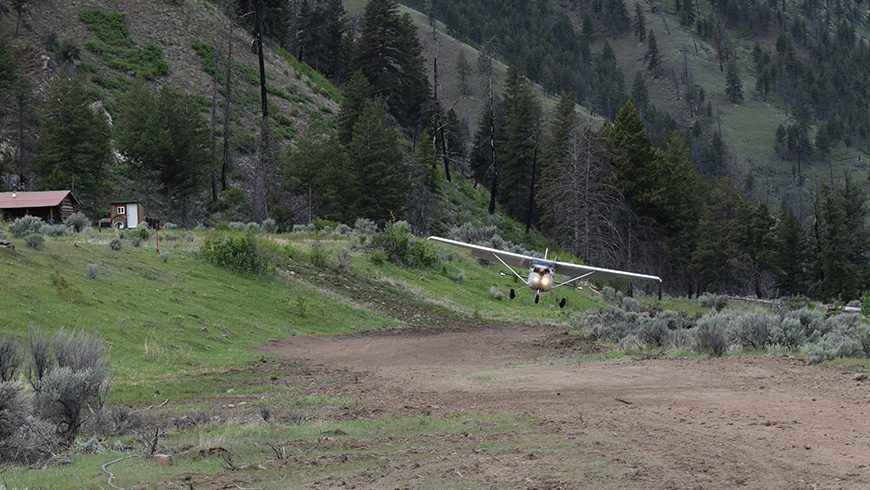
Dave Shallow, a pilot for Middle Fork Aviation, lands a Cessna 206 at Cougar Ranch on the Middle Fork of the Salmon River. Courtesy Dave Shallow
Idaho’s proliferation of backcountry airstrips was also fueled by the fact that the U.S. Forest Service (USFS) saw them as vital in helping to implement fire suppression tactics and combat wildland fire. “Smokejumpers and helicopter drops did not become developed techniques until much later,” Holm said, adding that airplane drops of manpower saved days of hiking and packing. Consequently, the USFS bought dozens of small remote airstrips, many of which had been built by hand by homesteaders or ranchers in the 1930s and 1940s. Holm pointed out that the first backcountry landing in Idaho was in 1925 at Stonebreaker Ranch in the Chamberlain Basin, which was significant due to its location in the later-designated Frank Church-River of No Return Wilderness and because, “historically, it shows the shift from mining and resource extraction to outfitting and tourism.”
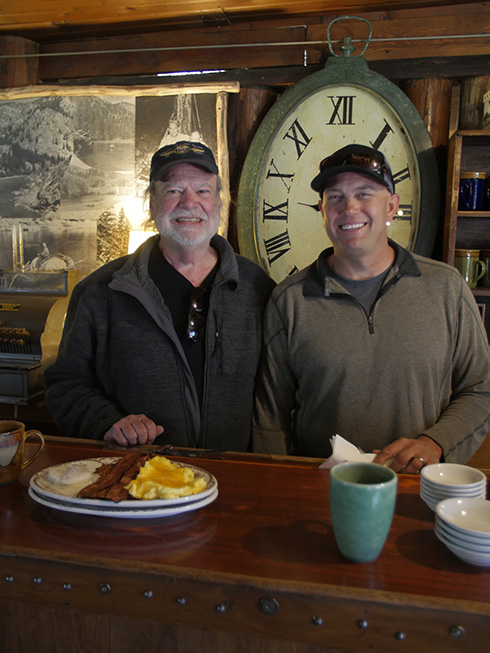
Pilots Galen Hanselman and Preston Ziegler meet for a “fly-in” breakfast at Sulphur Creek Ranch. Photo by John Plummer
Indeed, it was the boon in outfitting and recreation services after WWII—a trend that exploded in the central region of Idaho in the 1970s after the Middle Fork of the Salmon River was designated by Congress as part of the Wild and Scenic Rivers Act in 1968—that was one of the biggest contributors to use of Idaho’s backcountry airstrips.
Andrew George, president of the Idaho Aviation Association (IAA), remembered that the Banks-Lowman road was still a dirt road when he moved to the state in 1995. He drove everywhere before realizing that flying was one of the only ways to explore the landscape of his chosen home. “It was really humbling to see the landscape from up above and see how vast, and how remote and pristine it was,” George said.
Getting an exact count on the number of backcountry airstrips in Idaho is not easy. The Idaho Transportation Department Division of Aeronautics lists 32 state-owned and operated airports and 22 USFS airports for a total of 54 airstrips. But the Airport Master Records and Reports (FAA 5010 forms) lists 295 facilities with FAA site numbers in Idaho. Some of those might be heliports or private airstrips, but general estimates put more than 100 remote airstrips in the backcountry of central Idaho.
Hanselman’s “Fly Idaho!” book, now in its third edition and affectionately referred to as the Idaho backcountry bible, features 83 remote Idaho airstrips with detailed information on length, width, elevation, surface and airstrip conditions, tips or highlights. It’s the sort of information you would get from an experienced backcountry pilot, and reading it feels like talking to Hanselman over a cup of coffee. Detailed technical information is presented in the humble, no-nonsense manner typical of Hanselman. He has even developed his own rating system, the Relative Hazard Index (RHI), for assessing each airstrip’s difficulty on a scale of 0 to 50, taking into account such variables as approach, elevation, runway length, surface condition, terrain, obstacles, run out or departure—some of his criteria include abrupt turn required on final, lack of visibility, no-go around from flare, or departure over abrupt cliff or water.
For example, Lower Loon Creek, an airstrip owned by the Idaho Department of Fish and Game on the Middle Fork of the Salmon River, is classified with a RHI index of 36 in Hanselman’s book. The runway is only 25 feet wide and a debatable 1,200 feet long, with uneven grass and a cliff drop off over water at the downhill end that can make your stomach curdle and knees buckle as the cold-water sink sucks the belly of the plane down, dropping like a stone towards the river until the wind catches the wing and a banking right turn pulls you out of the canyon. It is not for the faint of heart and Hanselman’s caution regarding the upstream approach, downstream departure, river downdrafts and two-track centerline, among many others, are invaluable to pilots attempting this airstrip. Even still, Hanselman recommends taking an experienced pilot familiar with Lower Loon operations for your first flight.
“Flying in the backcountry takes practice,” Hanselman said. “It’s like playing a musical instrument, even if you know how to play all the notes, you have to practice.”
Mountain flying is dangerous. A quick review of the Idaho Aviation Accident Score Card (IAASC) indicates that the majority of aircraft accidents in 2016 were non-commercial fixed wing (private pilots) and 73 percent of those were due to pilot error.
“Situational awareness is the most important quality of any pilot,” said George of the IAA. “You have to be aware of the terrain and know the limits of both pilot and aircraft.”
Ziegler adds that learning your landmarks is just as important as understanding your own limitations. “You have to be aware of your surroundings and know the terrain,” said Ziegler, “both so you know where you are, and so you can accurately report your position to other pilots in the area.”
Hanselman, who has tens of thousands of hours in the cockpit claims that anybody can fly fast and high, it is slow flight that requires attention and practice. “An airplane is a marvelous thing,” he said. “When you can finally get to a point where it tells you what it wants to do and how it is acting. If you listen to how it sounds, how it feels, it feeds you all this information and it will tell you what it is capable of that day.”
“Aircraft technology and capabilities have changed dramatically in the last 30 years,” stated George, who believes the advancements in material compositions, tolerances and reliability have popularized backcountry flying. “You can’t stop the growth,” he added, “So, how we manage, caretake and regulate that growth becomes essential.”
The IAA was founded on the premise of always working to preserve, promote and protect aviation in Idaho, added George. “We need to be stewards of the land, even if flying above it most of the time.”
“Most pilots who operate in Idaho’s backcountry tend to be humble, understated folks,” said Hanselman, who added that large fly-ins to small remote airstrips just to “bag” the strip, while highly visible, simply don’t represent the majority of experienced backcountry pilots. And unlike the rapid growth rate of many other recreational activities like trail running or BMX biking (two of the segments with the highest growth at 35.5 percent and 43.2 percent, respectively), the annual growth rate of individuals earning the basic private pilot certificate is forecast by the FAA to grow less than one percent over the next 20 years.
“I wanted to share this fabulous asset that we have with the rest of the world,” said Hanselman. “By sharing it, we can protect it, otherwise it will disappear.”
TALL BUT TRUE TALES
Backcountry flying comes with its own tales of heroism, mishaps, legends and lore. Here are few tall but true tales of flying Idaho’s remote backcountry airstrips.
Cougars and Flying
This story involves Taylor Ranch, which became the University of Idaho Wilderness Field Station in 1969, in part through the creative vision of Bellevue resident and wildlife biologist Dr. Maurice Hornocker, who wanted to use the ranch as a base for research and aerial tracking of cougars. Hornocker, who is nationally and internationally recognized for his research on big cats worldwide, put the deal together and did extensive research on cougars in the Big Creek drainage that was pivotal in changing their classification from a bounty animal to a big game animal, subject to wildlife management.
The story begins in 1986 when pilot Mike Dorris of Johnson Flying Service was charged with flying three cougar kittens from Boise to the Taylor Ranch Wilderness Field Station. Abandoned at a young age, the kittens had been rehabilitated at the Boise Zoo and were now healthy enough to be reintroduced to the wild under the direction of Howard Quigley. Dorris picked up the sedated cougars, two small females and a larger male, and took off for Taylor Ranch. En route, weather obscured the normal flight path, and Dorris was forced to work his way around low-lying clouds and squalls. The extra time in the air found Dorris in a small Cessna 185 with a male cougar at his back that had begun to awake from the sedative. Dorris reached the ranch before it became an issue but says he will never forget the chilling screams from the male lion. “It made the hair on my neck stand up and added a bit of stress to the flight.” The cougars were unloaded and acclimated for some time before being released, and Dorris continued to fly many other animals connected to research at Taylor Ranch, including several live bighorn sheep (in 1988 for disease testing at a IDFG lab in Boise).
Story originally sourced from “Bound for the Backcountry: A History of Idaho’s Remote Airstrips” by Richard H. Holm, Jr.
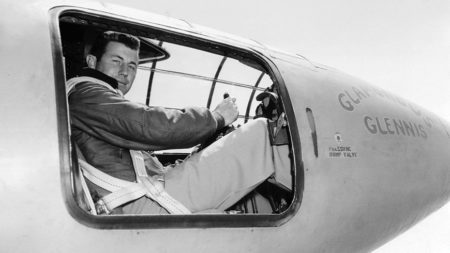
U.S. Air Force test pilot Chuck Yeager in the cockpit of the Bell X-1 “Glamorous Glennis” in which he broke the sound barrier. Photo c.1947 by USAF. Photo by IanDagnall Computing / Alamy Stock Photo
Chuck Yeager
This story takes place at the old Cape Horn airstrip (closed in 1972), where outfitter Bill Guth started pack trips for salmon fishing on the Middle Fork of the Salmon River. Back in the late 1940s or early 1950s, renowned test pilot Chuck Yeager flew in to go on a salmon fishing trip with Guth. Yeager flew in on a DC-3 or C-46 filled with several of his buddies. As Guth’s son, Norm, tells it in Dick Williams’ “Notes From the Cockpit: A Mountain Pilot’s Perspective,” the aircraft flew smoothly over, but then on final approach “… seemed to lose, rather than gain, control. The landing could hardly be called that. It was more like a controlled crash, bouncing and careening over the grass. Norm and Billy, Norm’s brother, were shocked. Could this be the famous Chuck Yeager? The aircraft jolted to a stop, the door opened, and Yeager and his buddies emerged, laughing, jabbing and jesting. As they gathered the gear up for the trip downstream, Norm couldn’t help himself any longer and had to ask Yeager if he had made the landing.
‘Well, son, we got in a little argument up there on who was going to get to land, so I got the yoke and left throttle, and my co-pilot took the rudders and right throttle.’”



